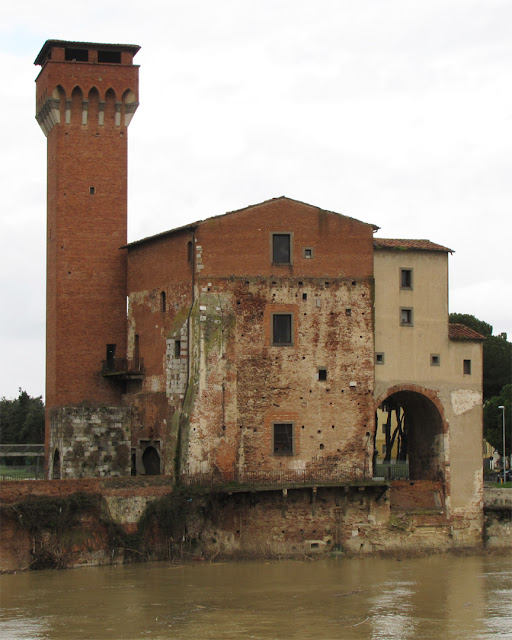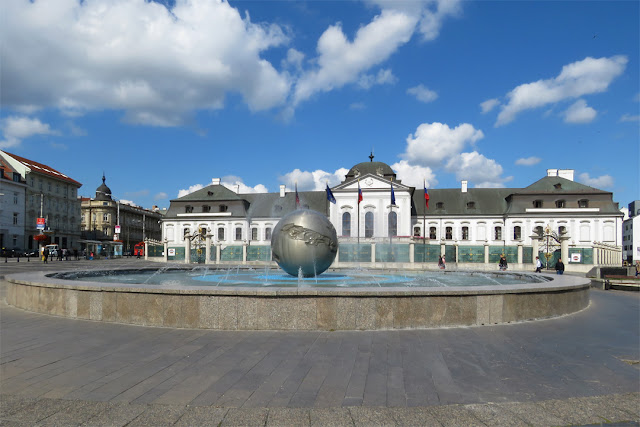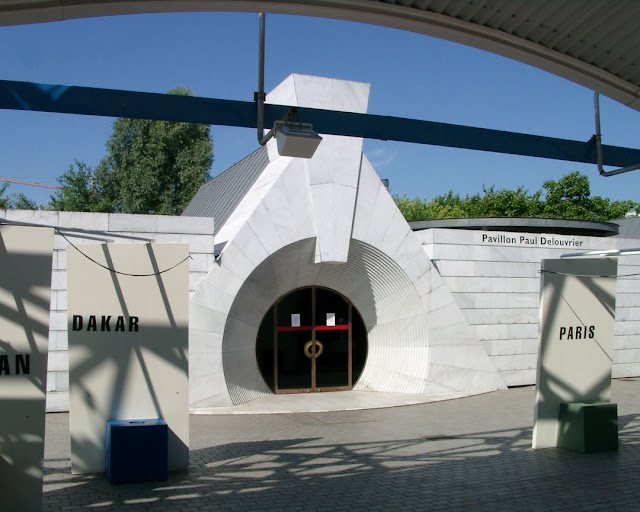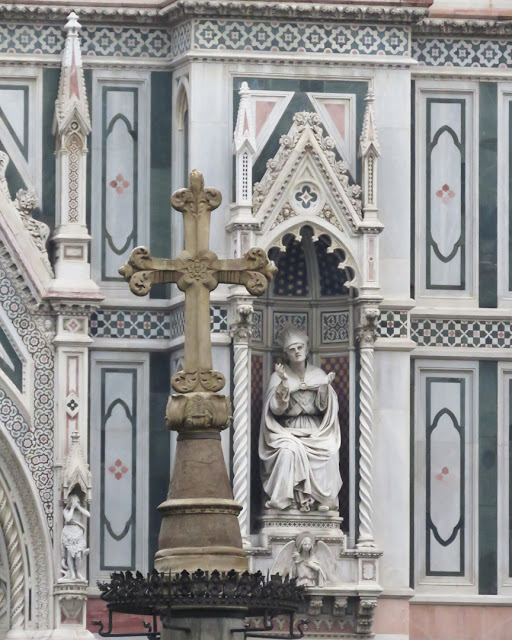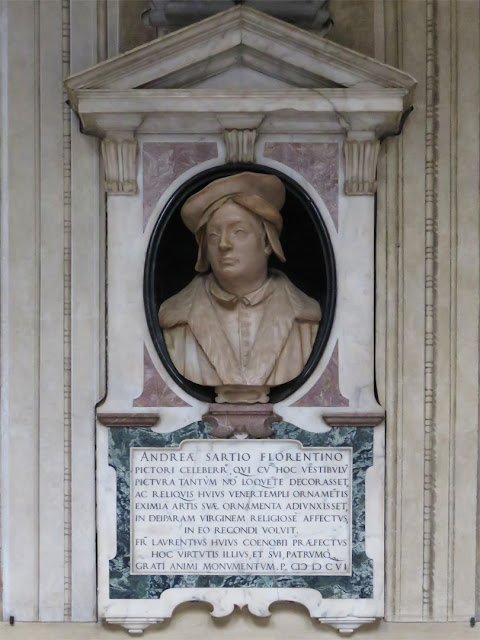Wednesday, February 28, 2018
Porcellino
“Porcellino” by Pietro Tacca, 1634
Museo Stefano Bardini
Palazzo Mozzi
Via dei Renai
Florence, January 2018
“Il Porcellino (piglet) is the local Florentine nickname for the bronze fountain of a boar. The fountain figure was sculpted and cast by Baroque master Pietro Tacca (1577–1640) shortly before 1634, following a marble Italian copy of a Hellenistic marble original, at the time in the Grand Ducal collections and today on display in the classical section of the Uffizi Museum. The original, which was found in Rome and removed to Florence in the mid-16th century by the Medici, was associated from the time of its rediscovery with the Calydonian Boar of Greek myth. Tacca's bronze, which has eclipsed the Roman marble that served as model, was originally intended for the Boboli Garden, then moved to the Mercato Nuovo in Florence, Italy; the fountain was placed originally facing east, in via Calimala, in front of the pharmacy that by association gained the name Farmacia del Cinghiale (Italian for ‘boar’). To gain more space for market traffic it was later moved to the side facing south, where it still stands as one of the most popular features for tourists. The present statue is a modern copy, cast in 1998 by Ferdinando Marinelli Artistic Foundry and replaced in 2008, while Tacca's bronze is sheltered in the new Museo Stefano Bardini in Palazzo Mozzi.” (Porcellino, Wikipedia)
Tuesday, February 27, 2018
The Ear
Ear sculpture painted by Johann Garber, 1997
ORF-Funkhaus Wien
Argentinierstraße
Vienna, September 2017
“The ‘Funkhaus’ in Vienna is not what it appears to be to the English native speaker - in German, ‘Funk’ refers to radio signals in communication and media. And the ‘Funkhaus’ is the old headquarter of the National Austrian Broadcast, the ORF (my former employer). The Funkhaus can be found in the Argentiniastraße, and if you refer to this road, people often immediately associate it with the Funkhaus - which is sometimes also called ‘Radiokulturhaus’. This is the official name, but less common in vernacular use.” (Funkhaus, MyCountry.com)
Monday, February 26, 2018
Arup Headquarters
Arup Headquarters
Fitzroy Street
London, January 2008
“Phases 2 and 3 of the redevelopment of Arup’s headquarters replace two 1960s buildings to provide five levels of offices and associated meeting rooms, reception, café, library, conference and exhibition space. This supplements Phase 1, 13 Fitzroy Street completed in 2005 also by Sheppard Robson. The building is designed around a central, full-height, open atrium, providing natural daylight to varying depths of floorplates and enabling interaction and connectivity through the building. The design of the atrium was only possible through developing a bespoke horizontal retractable fire curtain at alternate floor levels, maximising the views of a full-height feature glass wall by Alex Beleschenko.” (Arup, No. 8 Fitzroy Street, Sheppard Robson)
Sunday, February 25, 2018
Secret Garden of Flora
Secret garden and stairway Villa Torrigiani Camigliano, Capannori Lucca, October 2017
“There is a small garden, enclosed by a network and used as an aviary, a fish farm with jets of water, and the secret garden of Flora with an Italian nymphaeum. The heart of the park is the Nymphaeum of Winds, named for the statues personifying the winds, where the paths converge.” (Villa Torrigiani, Wikipedia)
Saturday, February 24, 2018
Hősök tere
Hősök tere (Heroes' Square)
Budapest, September 2017
“Hősök tere (Heroes' Square) is one of the major squares in Budapest, Hungary, noted for its iconic statue complex featuring the Seven chieftains of the Magyars and other important Hungarian national leaders, as well as the Memorial Stone of Heroes, often erroneously referred as the Tomb of the Unknown Soldier. The square lies at the outbound end of Andrássy Avenue next to City Park(Városliget). It hosts the Museum of Fine Artsand the Műcsarnok. The square has played an important part in contemporary Hungarian history and has been a host to many political events, such as the reburial of Imre Nagy in 1989. The sculptures were made by sculptor Zala György from Lendava.” (Hősök tere, Wikipedia)
Friday, February 23, 2018
Thursday, February 22, 2018
Wednesday, February 21, 2018
Brandenburg Gate quadriga
Quadriga by Johann Gottfried Schadow, 1793
Brandenburg Gate
Pariser Platz
Berlin, September 2011
“After Napoleon's defeat in 1814 and the Prussian occupation of Paris by General Ernst von Pfuel, the quadriga was restored to Berlin. It was now redesigned by Karl Friedrich Schinkel for the new role of the Brandenburg Gate as a Prussian triumphal arch. The goddess, now definitely Victoria, was equipped with the Prussian eagle and Iron Cross on her lance with a wreath of oak leaves. The quadriga faces east, as it did when it was originally installed in 1793. Only the royal family was allowed to pass through the central archway, as well as members of the Pfuel family, from 1814 to 1919. The Kaiser granted this honour to the family in gratitude to Ernst von Pfuel, who had overseen the return of the quadriga to the top of the gate. In addition, the central archway was also used by the coaches of ambassadors on the single occasion of their presenting their letters of credence to council.” (Brandenburg Gate, Wikipedia)
Tuesday, February 20, 2018
Le Poète chevauchant Pégase
“Le Poète chevauchant Pégase” (The Poet Riding Pegasus), by Alexandre Falguière, 1897
Square de l'Opéra-Louis-Jouvet
Quartier de la Chaussée-d'Antin, 9th arrondissement
Paris, July 2012
“This amazing sculpture is the work of Alexander Falguière (1831-1900). She is a Poet riding Pegasus. We must examine the Greek mythology to understand what bond unites the poet and the animal. Pegasus is a magical flying horse, as swift as the wind, which was born from the blood of Medusa when it was beheaded by Perseus. Pegasus then joined the gods of Olympus and it was thunder and lightning of Zeus. In Greek, her name means ‘the source’. Indeed, it is supposed to have snapped, striking his hoof on Mount Helicon – home of the Muses – and the Hippocrene drink where poets. Pegasus is the symbol of poetry.” (Patryst)
Monday, February 19, 2018
Old Citadel
Cittadella and Torre Guelfa
(Citadel and Guelph Tower)
Piazza di Terzanaia
Pisa, March 2013
“The area of the medieval ‘Tersana’ (darsena or shipyard) expanded during 13th century at the time when military victories and the flowering of overseas commerce made it necessary for the city to find a suitable site for naval purposes. Military defeats in the following century and a crisis in mercantile activities caused this area to be turned into a fortress, with the first battlements in brickwork on the walls. The Tersana, gradually enhanced with the addition of other towers (the Ghibellina, St. George and the towers on the Arno (or Degazia), definitively became a fortress under the Florence after 1406, when the wall along the river was strengthened and a completely new tower, 18m tall, the torre Guelfa (or Citadel tower), was built. It was given the name Guelfa in contraposition to the Ghibellina tower.” (Torre Guelfa and the old Citadel, Terre di Pisa)
Sunday, February 18, 2018
Hanavský Pavilion
Hanavský pavilon (Hanavský Pavilion) by Komárov Ironworks, 1891
Letenské sady (Letná Park), Holešovice
Prague, September 2017
“One of the most impressive Art Nouveau structures in the city, it was originally built as the representative pavilion of the Komárov Ironworks for the Prague Jubilee Exhibition in 1891. It was the first cast iron structure in Prague, and today it’s a luxury restaurant with one of the most beautiful panoramic views of the Prague bridges.” (Hanavský Pavilion, Prague City Tourism)
Saturday, February 17, 2018
Triton Square
Triton Square
Regent's Place
Camden
London, January 2007
“Work by British Land commenced in 1996. The first stage involved the demolition of the head office and studios of the former ITV company Thames Television and the subsequent development of the central part of the site and much of the Euston Road frontage, with four new office buildings and a pedestrian plaza called Triton Square. One of these buildings called 2-3 Triton Square was a new headquarters for what was then the UK's fifth largest bank by gross assets, Abbey National. The lower levels of Euston Tower were modernised at the same time. The development includes a shopping mall and an open space Triton Square that includes art features by Langlands and Bell. The developers also commissioned a large mural by Michael Craig-Martin a lighting scheme by Liam Gillick and a smaller sculptural installation by Antony Gormley.” (Regent's Place, Wikipedia)
Friday, February 16, 2018
Thursday, February 15, 2018
Grassalkovich Palace
Zem - planéta mieru (Earth - planet of peace) by Tibor Bártfay, Pavel Mikšík, Karol Lacko, 1982
Grasalkovičov palác (Grassalkovich Palace)
Hodžovo námestie, Staré Mesto (Old Town)
Bratislava, September 2017
“During the 1939–1945 period, the palace was adapted by Emil Belluš and became the seat of the president of the First Slovak Republic (i.e. of Jozef Tiso). During the Communist era, it was first (after 1945) the seat of the Council of Commissioners (also styled Corps of Plenipotentiaries), which was a quasi-government of Slovakia within Czechoslovakia. In 1950, the building was turned into the ‘Klement Gottwald House of Pioneers and Youth’ (Dom pionierov a mládeže Klementa Gottwalda), which was an activity center for Bratislava's schoolchildren, all of whom were so-called pioneers at that time. The schoolchildren caused extensive damage to the palace, and the necessary restoration only became possible following the transition from Communism in late 1989 with the Velvet Revolution. The restoration of Grassalkovich Palace during the early 1990s was overseen by the inaugural First Lady of Slovakia, Emília Kováčová. Following its restoration, the palace became the residence of Slovakia's president on 30 September 1996. Its once-large gardens are now a public park, complete with a statue of Bratislava-born composer Jan Nepomuk Hummel.” (Grassalkovich Palace, Wikipedia)
Wednesday, February 14, 2018
Pavillon Paul Delouvrier
Pavillon Paul Delouvrier by Óscar Tusquets, 1991
Parc de La Villette, Avenue Jean Jaurès
Quartier du Pont-de-Flandre, 19th arrondissement
Paris, July 2004
“The Pavillon Paul Delouvrier was designed by the Catalan architect, Oscar Tusquets with a sleek and ultra modern appearance that incorporates three different geometric shapes to make up the main event and temporary exhibition rooms, which are oval, square and triangle. The different rooms are separated by winter gardens and there are also three terraces that look out over the Parc de la Villette, and the pavilion itself is covered with white marble, which came from the Andalucia region of Spain.” (Pavillon Paul Delouvrier at Parc de la Villette)
Tuesday, February 13, 2018
Stairs
Stairs behind the facade
San Michele in Foro
Piazza San Michele
Lucca, October 2017
“San Michele in Foro is a Roman Catholic basilica church in Lucca, Tuscany, central Italy, built over the ancient Roman forum. Until 1370 it was the seat of the Consiglio Maggiore (Major Council), the commune's most important assembly. It is dedicated to Archangel Michael. The church is mentioned for the first time in 795 as ad foro (in the forum). It was rebuilt after 1070 by will of Pope Alexander II. Notable is the façade, from the 13th century, with a large series of sculptures and inlays, numerous of which remade in the 19th century. The lower part has a series of blind arcades, the central of which includes the main portal. The upper part, built using plenty of iron materials to counter wind, has four orders of small loggias. On the summit, flanked by two other angels, is the 4 m-tall statue of St. Michael the Archangel. According to a legend, an angel's finger would have a huge diamond. On the lower right corner of the façade is a statue (1480) of the Madonna salutis portus, sculpted by Matteo Civitali to celebrate the end of the 1476 plague.” (San Michele in Foro, Wikipedia)
Monday, February 12, 2018
Cellini Salt Cellar
Cellini Salt Cellar by Benvenuto Cellini, 1543
Kunsthistorisches Museum (Museum of Art History)
Maria-Theresien-Platz
Vienna, September 2017
“The Cellini Salt Cellar (in Vienna called the Saliera, Italian for salt cellar) is a part-enamelled gold table sculpture by Benvenuto Cellini. It was completed in 1543 for Francis I of France, from models that had been prepared many years earlier for Cardinal Ippolito d'Este. The Cellini Salt Cellar depicts a male figure representing the sea and a female figure that represents the earth. A small vessel meant to hold salt is placed next to the male figure. A temple-shaped box for pepper is placed next to the female figure. It came into the possession of the Habsburgs as a gift by Charles IX of France to Archduke Ferdinand II of Tyrol, who had acted as a proxy for Charles in his wedding to Elisabeth of Austria. It was originally part of the Habsburg art collection at Castle Ambras, but was transferred to the Kunsthistorisches Museum in Vienna during the 19th century.” (Cellini Salt Cellar, Wikipedia)
Sunday, February 11, 2018
Walther Tell
Walther Tell (son of Wilhelm)
Haus der Schweiz (House of Switzerland)
Unter den Linden / Friedrichstraße
Berlin, September 2011
“A figure of Walther Tell was attached to the Swiss House in Berlin. Originally, a figure of Wilhelm Tell was to be installed on the building, which was completed in 1936. However, the responsible administrative authorities in the Third Reich had forbidden a depiction of the freedom fighter, so that a figure of Walther, Wilhelm Tell's son, was installed as a compromise.” (Telldenkmal, Wikipedia)
Saturday, February 10, 2018
Je me souviens
“Je me souviens” by Jean-Michel Folon, 2003
Giardino delle rose (Rose Garden)
Via Poggi
Florence, January 2018
“A permanent exhibition dedicated to the world-famous Belgian artist Jean Michel Folon is on display in the rose garden. Eleven statues (nine bronze sculptures and two plaster models) by the visionary artist adorn the walks of the garden, in perfect symbiosis with the surrounding environment. Je me souviens, a work of 2003, features a male figure sitting on a bench ready to converse with whomever happens to come and sit next to him.” (Following Folon in Florence’s Rose Garden, SlowItaly)
Friday, February 9, 2018
Buda Castle
Buda Castle (Budavári Palota)
Castle Hill, Várnegyed (Castle District)
Budapest, September 2017
“Buda Castle (Budavári Palota) is the historical castle and palace complex of the Hungarian kings in Budapest. It was first completed in 1265, but the massive Baroque palace today occupying most of the site was built between 1749 and 1769. The complex in the past was referred to as either the Royal Palace (Hungarian: Királyi-palota) or the Royal Castle (Királyi Vár). The castle now houses the Hungarian National Gallery and The Budapest History Museum. Buda Castle sits on the south tip of Castle Hill, bounded on the north by what is known as the Castle District (Várnegyed), which is famous for medieval, Baroque and 19th-century houses, churches and public buildings. The hill is linked to Clark Ádám Square and the Széchenyi Chain Bridge by the Castle Hill Funicular. The castle is a part of the Budapest World Heritage Site, so declared in 1987.” (Buda Castle, Wikipedia)
Thursday, February 8, 2018
Wednesday, February 7, 2018
Column of Saint Zanobi
Detail of the facade of Santa Maria del Fiore (Saint Mary of the Flower)
Colonna di San Zanobi (Column of Saint Zanobi)
Florence, January 2018
Tuesday, February 6, 2018
Galerie Vivienne
Galerie Vivienne by Francois Jean Delannoy, 1826
Rue des Petits Champs
Quartier Vivienne, 2nd arrondissement
Paris, July 2005
“The Galerie Vivienne is one of the covered passages of Paris, France, located in the 2nd arrondissement. It is 176 metres (577 ft) long and 3 metres (9.8 ft) wide. The gallery has been registered as a historical monument since 7 July 1974. The gallery was built in 1823 by Marchoux, President of the Chamber of Notaries, at the location of the Vanel de Serrant hotel and the Petits Peres passage. It was based on plans drawn up by the architect Francois Jean Delannoy. Inaugurated in 1826 under the name Marchoux, but soon renamed Vivienne, the gallery took advantage of its unique location. It attracted many visitors with its tailor shops, cobblers, wine shop, restaurant, Jousseaume bookstore, draper, confectioner, print-seller and so on. Located between the Palais-Royal, the Paris Bourse (stock exchange) and the Grands Boulevards, the passage enjoyed considerable success until the end of the Second Empire. But the gallery lost some of its appeal with the move of the prestigious shops to the Madeleine and the Champs-Élysées, and particularly because of the Restauration Haussmann of Paris by Georges-Eugène Haussmann.” (Galerie Vivienne, Wikipedia)
Monday, February 5, 2018
“Elbis”
“Elbis” tourist boat
Vltava river
Prague, September 2017
“Sidewheelers are used as riverboats and as coastal craft. Though the side wheels and enclosing sponsons make them wider than sternwheelers, they may be more maneuverable, since they can sometimes move the paddles at different speeds, and even in opposite directions. This extra maneuverability makes sidewheelers popular on the narrower, winding rivers of the Murray-Darling system in Australia, where a number still operate.” (Sidewheeler, Wikipedia)
Sunday, February 4, 2018
Galileo
Statue of Galileo by Stefania Guidi
Lungarno Ranieri Simonelli
Pisa, March 2013
“Cardinal Pietro Maffi (1858—1931) wasn't your usual porporate: he was a scientist, an astronomer and the director the Vatican Observatory since 1904. In 1922, when he was Archbishop of Pisa, proposed to erect a statue of Galileo Galilei in piazza dei Miracoli, to make an amend of sorts to the scientist condemned by the Inquisition as a heretic, but nothing came out of this at the time. About twenty years ago Flaminio Farnesi, a Pisan entrepreneur, commissioned a 5-meter bronze statue of Galileo to the sculptress Stefania Guidi. When the work was ready the city of Pisa wasn't yet able or willing to find a suitable location for it, so Mr. Farnesi placed the statue at the entrance of his factory. Only recently he succeeded in getting the monument erected in Pisa, on Lungarno Ranieri Simonelli. How did he managed that? Mr. Farnesi seriously threatened to donate the bronze to Livorno...” (Galileo, Livorno Daily Photo)
Saturday, February 3, 2018
Parc Güell
One of the viaducts
Parc Güell (Park Güell)
Carmel Hill
Barcelona, March 2017
“One of the three viaducts located within the park. Originally created by Antoni Gaudí to allow carriages to easily facilitate the transportation of visitors from the park's entrance to the ‘Turó de Tres Creus’ which can be found on the top of the mountain, these viaducts continue to allow guests to travel throughout the park.” (Park Güell, Wikipedia)
Friday, February 2, 2018
Bratislavský hrad
Bratislavský hrad (Bratislava Castle)
Staré Mesto (Old Town)
Bratislava, September 2017
“Bratislava Castle (Slovak: Bratislavský hrad, German: Pressburger Schloss, Hungarian: Pozsonyi Vár) is the main castle of Bratislava, the capital of Slovakia. The massive rectangular building with four corner towers stands on an isolated rocky hill of the Little Carpathians directly above the Danube river in the middle of Bratislava. Because of its size and location, it has been a dominant feature of the city for centuries.” (Bratislava Castle, Wikipedia)
Thursday, February 1, 2018
Bust of Andrea del Sarto
Bust of Andrea del Sarto by Giovanni Caccini
Chiostrino dei Voti
Basilica della Santissima Annunziata (Basilica of the Most Holy Annunciation)
Piazza della Santissima Annunziata
Florence, January 2018
Subscribe to:
Posts (Atom)










